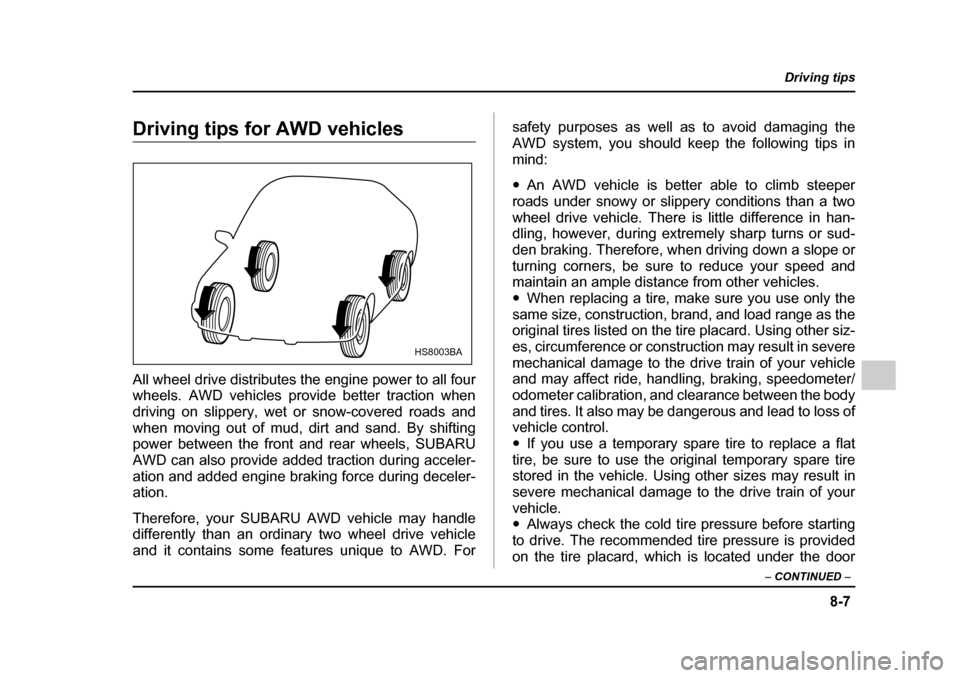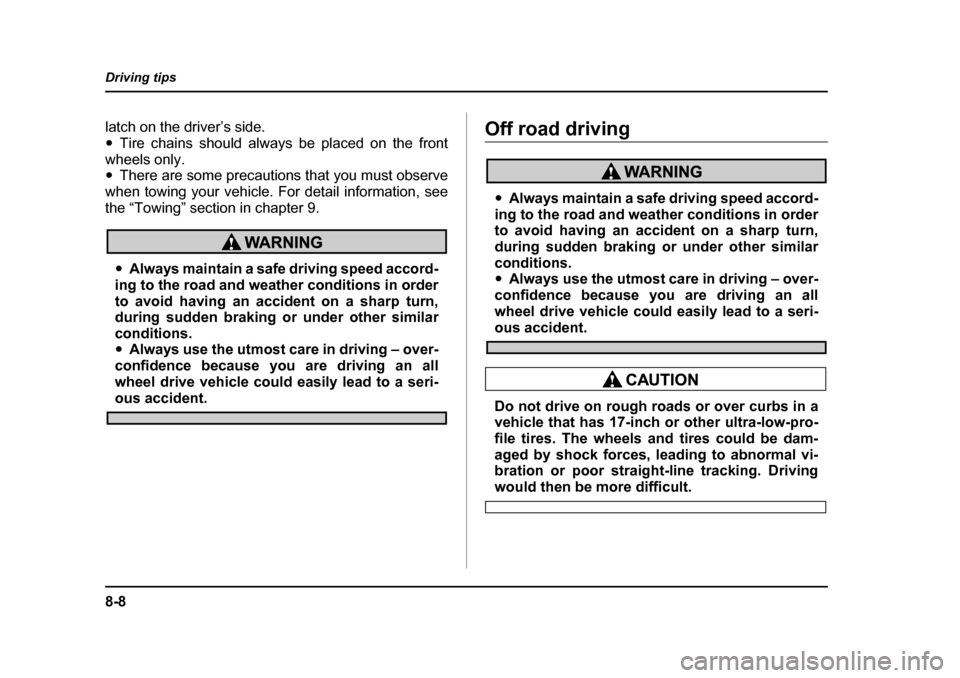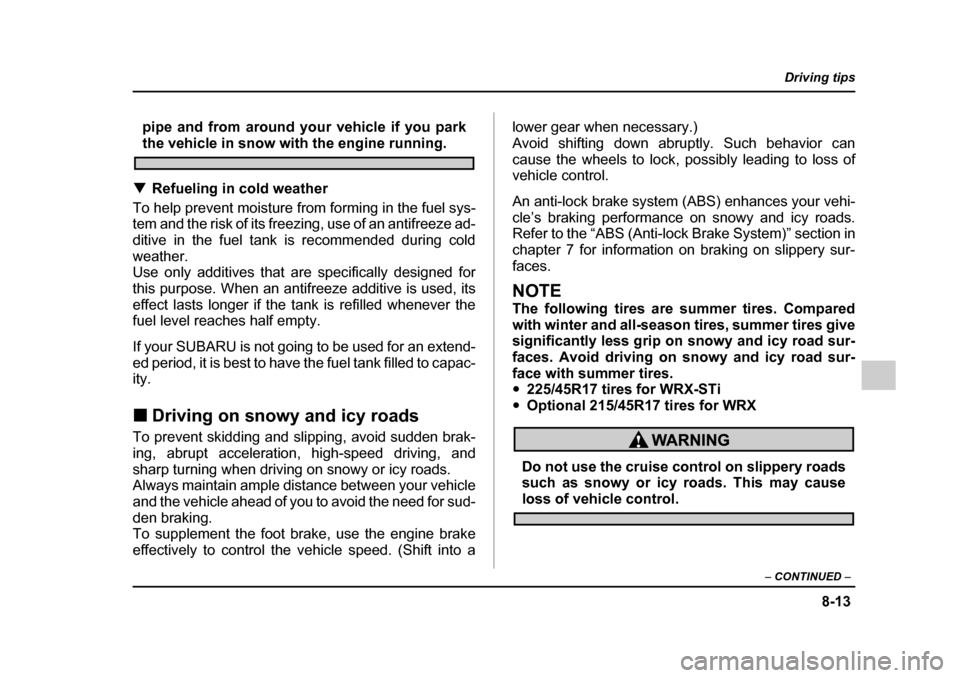2005 SUBARU IMPREZA tires
[x] Cancel search: tiresPage 308 of 507

8-1
8
Driving tips
New vehicle break-in driving – the first 1,000 miles (1,600 km) ................ 8-2
Fuel economy hints ...................................... 8-2
Engine exhaust gas (Carbon monoxide) .... 8-3
Catalytic converter ....................................... 8-4
Periodic inspections .................................... 8-6
Driving in foreign countries ......................... 8-6
Driving tips for AWD vehicles ..................... 8-7
Off road driving ............................................ 8-8 All AWD models except OUTBACK SPORT and vehicles with 17 inch tires ..................... 8-9
OUTBACK SPORT ............................................. 8-9
Winter driving ............................................... 8-11 Operation during cold weather ........................ 8-11
Driving on snowy and icy roads ...................... 8-13
Corrosion protection ........................................ 8-14
Snow tires .......................................................... 8-14
Tire chains ......................................................... 8-16
Rocking the vehicle .......................................... 8-16
Loading your vehicle ................................... 8-17 Vehicle capacity weight .................................... 8-19
GVWR and GAWR (Gross Vehicle Weight Rating and Gross Axle Weight Rating) ........ 8-19
Roof rail and crossbar (if equipped) ............... 8-20
Trailer hitch (if equipped) ............................ 8-25 Connecting a trailer .......................................... 8-25
When you do not tow a trailer .......................... 8-28
Trailer towing ................................................ 8-29 Warranties and maintenance ........................... 8-29 Maximum load limits ........................................ 8-29
Trailer hitches ................................................... 8-34
Connecting a trailer .......................................... 8-35
Trailer towing tips ............................................. 8-37
Page 309 of 507

8-2
Driving tips
Driving tipsNew vehicle break-in driving – the
first 1,000 miles (1,600 km)
The performance and long life of your vehicle are de-
pendent on how you handle and care for your vehicle
while it is new. Follow these instructions during the
first 1,000 miles (1,600 km):�y
Do not race the engine. And do not allow engine
speed to exceed 4,000 rpm except in an emergency.�y Do not drive at one constant engine or vehicle
speed for a long time, either fast or slow. �y Avoid starting suddenly and rapid acceleration, ex-
cept in an emergency. �y Avoid hard braking, except in an emergency.
The same break-in procedures should be applied to
an overhauled engine, newly mounted engine or when
brake pads or brake linings are replaced with new
ones.
Fuel economy hints
The following suggestions will help to save your fuel. �y Select the proper gear position for the speed and
road conditions. �y Avoid sudden acceleration or deceleration. Always
accelerate gently until you reach the desired speed.
Then try to maintain that speed for as long as possible. �y Do not pump the accelerator and avoid racing the
engine. �y Avoid unnecessary engine idling.
�y Keep the engine properly tuned.
�y Keep the tires inflated to the correct pressure shown
on the tire placard, which is located under the door
latch on the driver’s side. Low pressure will increase
tire wear and fuel consumption.�y Use the air conditioner only when necessary.
�y Keep the front and rear wheels in proper alignment.
�y Avoid carrying unnecessary luggage or cargo.
Page 314 of 507

8-7
Driving tips
– CONTINUED –
Driving tips for AWD vehicles
All wheel drive distributes the engine power to all four
wheels. AWD vehicles provide better traction when
driving on slippery, wet or snow-covered roads and
when moving out of mud, dirt and sand. By shifting
power between the front and rear wheels, SUBARU
AWD can also provide added traction during acceler-
ation and added engine braking force during deceler-
ation.
Therefore, your SUBARU AWD vehicle may handle
differently than an ordinary two wheel drive vehicle
and it contains some features unique to AWD. For safety purposes as well as to avoid damaging the
AWD system, you should keep the following tips inmind: �y
An AWD vehicle is better able to climb steeper
roads under snowy or slippery conditions than a two
wheel drive vehicle. There is little difference in han-
dling, however, during extremely sharp turns or sud-
den braking. Therefore, when driving down a slope or
turning corners, be sure to reduce your speed and
maintain an ample distance from other vehicles. �y When replacing a tire, make sure you use only the
same size, construction, brand, and load range as the
original tires listed on the tire placard. Using other siz-
es, circumference or construction may result in severe
mechanical damage to the drive train of your vehicle
and may affect ride, handling, braking, speedometer/
odometer calibration, and clearance between the body
and tires. It also may be dangerous and lead to loss of
vehicle control. �y If you use a temporary spare tire to replace a flat
tire, be sure to use the original temporary spare tire
stored in the vehicle. Using other sizes may result in
severe mechanical damage to the drive train of your
vehicle. �y Always check the cold tire pressure before starting
to drive. The recommended tire pressure is provided
on the tire placard, which is located under the door
HS8003BA
Page 315 of 507

8-8
Driving tips
latch on the driver’s side. �y
Tire chains should always be placed on the front
wheels only. �y There are some precautions that you must observe
when towing your vehicle. For detail information, see
the “Towing” section in chapter 9.
�y Always maintain a safe driving speed accord-
ing to the road and weather conditions in order
to avoid having an accident on a sharp turn,
during sudden braking or under other similar
conditions. �y Always use the utmost care in driving – over-
confidence because you are driving an all
wheel drive vehicle could easily lead to a seri-
ous accident.
Off road driving
�y Always maintain a safe driving speed accord-
ing to the road and weather conditions in order
to avoid having an accident on a sharp turn,
during sudden braking or under other similar
conditions.�y Always use the utmost care in driving – over-
confidence because you are driving an all
wheel drive vehicle could easily lead to a seri-
ous accident.
Do not drive on rough roads or over curbs in a
vehicle that has 17-inch or other ultra-low-pro-
file tires. The wheels and tires could be dam-
aged by shock forces, leading to abnormal vi-
bration or poor straight-line tracking. Driving
would then be more difficult.
Page 316 of 507

8-9
Driving tips
– CONTINUED –
�„All AWD models except OUTBACK
SPORT and vehicles with 17 inch tires
Your AWD vehicle is neither a conventional off-road
vehicle nor an all terrain vehicle. It is a passenger ve-
hicle designed primarily for on-road use. The AWD
feature gives it some limited off-road capabilities in sit-
uations in which driving surfaces are relatively level,
obstruction-free and otherwise similar to on-road driv-
ing conditions. Operating it under other than those
conditions could subject the vehicle to excessive
stress which might result in damage not eligible for re-
pair under warranty. If you do take your SUBARU off
road, you should review the common sense precau-
tions in the next section (applicable to the OUTBACK
SPORT) for general guidance. But please keep in
mind that your vehicle’s off-road capabilities are more
limited than those of the OUTBACK SPORT.
Never attempt to drive through pools and puddles, or
roads flooded with water. Water entering the engine
air intake or the exhaust pipe or water splashing onto
electrical parts may damage your vehicle and may
cause it to stall. �„ OUTBACK SPORT
Your Subaru can be driven on ordinary roads or off-
road. But please keep in mind that an AWD SUBARU is a passenger vehicle and is neither a conventional
off-road vehicle nor an all-terrain vehicle. If you do
take your Subaru off-road, certain common sense pre-
cautions such as the following should be taken: �y
Make certain that you and all of your passengers
are wearing seatbelts. �y Carry some emergency equipment, such as a tow-
ing rope or chain, a shovel, wheel blocks, first aid kit
and cell phone or citizens band radio. �y Drive carefully. Do not take unnecessary risks by
driving in dangerous areas or over rough terrain. �y Slow down and employ extra caution at all times.
When driving off-road, you will not have the benefit of
marked traffic lanes, banked curves, traffic signs and
the like. �y Do not drive across steep slopes. Instead, drive ei-
ther straight up or straight down the slopes. A vehicle
can much more easily tip over sideways than it can
end over end. Avoid driving straight up or down slopes
that are too steep.�y Avoid sharp turning maneuvers, especially at higher
speeds. �y Do not grip the inside or spokes of the steering
wheel. A bad bump could jerk the wheel and injure
your hands. Instead drive with your fingers and
thumbs on the outside of the rim.�y If driving through water, such as when crossing
Page 317 of 507

8-10
Driving tips
shallow streams, first check the depth of the water and
the bottom of the stream bed for firmness and ensure
that the bed of the stream is flat. Drive slowly and com-
pletely through the stream. The water should be shal-
low enough that it does not reach the vehicle’s under-
carriage. Water entering the engine air intake or the
exhaust pipe or water splashing onto electrical parts
may damage your vehicle and may cause it to stall.
Never attempt to drive through rushing water; regard-
less of its depth, it can wash away the ground from un-
der your tires, resulting in possible loss of traction and
even vehicle rollover. �y
Always check your brakes for effectiveness immedi-
ately after driving in sand, mud or water. Do this by
driving slowly and stepping on the brake pedal. Re-
peat that process several times to dry out the brake
discs and brake pads.�y Do not drive or park over or near flammable materi-
als such as dry grass or fallen leaves, as they may
burn easily. The exhaust system is very hot while the
engine is running and right after the engine stops. This
could create a fire hazard. �y After driving through tall grass, mud, rocks, sand,
rivers, etc., check that there is no grass, bush, paper,
rags, stones, sand, etc. adhering to or trapped on the
underbody. Clear off any such matter from the under-
body. If the vehicle is used with these materials trapped or adhering to the underbody, a mechanical
breakdown or fire could occur.�y
Secure all cargo carried inside the vehicle and make
certain that it is not piled higher than the seatbacks.
During sudden stops or jolts, unsecured cargo could
be thrown around in the vehicle and cause injury. Do
not pile heavy loads on the roof. Those loads raise the
vehicle’s center of gravity and make it more prone to
tip over. �y If you must rock the vehicle to free it from sand or
mud, depress the accelerator pedal slightly and move
the selector lever back and forth between “D” and “R”
repeatedly. Do not race the engine. For the best pos-
sible traction, avoid spinning the wheels when trying to
free the vehicle.
When the road surface is extremely slippery, you can
obtain better traction by starting the vehicle with the
transmission in 2nd than 1st (both for MT and AT). �y Never equip your vehicle with tires larger than those
specified in this manual. �y Frequent driving of an AWD vehicle under hard-driv-
ing conditions such as rough roads or off roads will ne-
cessitate more frequent replacement of engine oil,
brake fluid and transmission oil than that specified in
the maintenance schedule described in the “Warranty
and Maintenance Booklet”.
Remember that damage done to your Subaru while
Page 319 of 507

8-12
Driving tips
starting.
Keep the door locks from freezing by squirting them
with deicer or glycerin.
Forcing a frozen door open may damage or separate
the rubber weather strips around the door. If the door
is frozen, use hot water to melt the ice, and afterwards
thoroughly wipe the water away.
Use a windshield washer fluid that contains an anti-
freeze solution. Do not use engine antifreeze or other
substitutes because they may damage the paint of the
vehicle. �T
Before driving your vehicle
Before entering the vehicle, remove any snow or ice
from your shoes because that could make the pedals
slippery and dangerous.
While warming up the vehicle before driving, check
that the accelerator pedal, brake pedal, and all other
controls operate smoothly.
Clear away ice and snow that has accumulated under
the fenders to avoid making steering difficult. During
severe winter driving, stop when and where it is safe
to do so and check under the fenders periodically. �T
Parking in cold weather
Do not use the parking brake when parking for long
periods in cold weather since it could freeze in that po-
sition. Instead, observe the following:
1. Place the shift lever in “1” or “R” for manual trans-
mission vehicles, and in “P” for automatic transmission
vehicles.
2. Use tire stops under the tires to prevent the vehicle
from moving.
When the vehicle is parked in snow or when it snows,
raise the wiper blades off the glass to prevent damage to them.
When the vehicle has been left parked after use on
roads heavily covered with snow, or has been left
parked during a snowstorm, icing may develop on the
brake system, which could cause poor braking action.
Check for snow or ice buildup on the suspension, disc
brakes and brake hoses underneath the vehicle.
If there is caked snow or ice, remove it, being careful
not to damage the disc brakes and brake hoses and ABS harness.
Snow can trap dangerous exhaust gases under
your vehicle. Keep snow clear of the exhaust
Page 320 of 507

8-13
Driving tips
– CONTINUED –
pipe and from around your vehicle if you park
the vehicle in snow with the engine running.
�T Refueling in cold weather
To help prevent moisture from forming in the fuel sys-
tem and the risk of its freezing, use of an antifreeze ad-
ditive in the fuel tank is recommended during cold
weather.
Use only additives that are specifically designed for
this purpose. When an antifreeze additive is used, its
effect lasts longer if the tank is refilled whenever the
fuel level reaches half empty.
If your SUBARU is not going to be used for an extend-
ed period, it is best to have the fuel tank filled to capac-
ity. �„ Driving on snowy and icy roads
To prevent skidding and slipping, avoid sudden brak-
ing, abrupt acceleration, high-speed driving, and
sharp turning when driving on snowy or icy roads.
Always maintain ample distance between your vehicle
and the vehicle ahead of you to avoid the need for sud-
den braking.
To supplement the foot brake, use the engine brake
effectively to control the vehicle speed. (Shift into a lower gear when necessary.)
Avoid shifting down abruptly. Such behavior can
cause the wheels to lock, possibly leading to loss of
vehicle control.
An anti-lock brake system (ABS) enhances your vehi-
cle’s braking performance on snowy and icy roads.
Refer to the “ABS (Anti-lock Brake System)” section in
chapter 7 for information on braking on slippery sur-faces.
NOTE
The following tires are summer tires. Compared
with winter and all-season tires, summer tires give
significantly less grip on snowy and icy road sur-
faces. Avoid driving on snowy and icy road sur-
face with summer tires. �y
225/45R17 tires for WRX-STi
�y Optional 215/45R17 tires for WRX
Do not use the cruise control on slippery roads
such as snowy or icy roads. This may cause
loss of vehicle control.